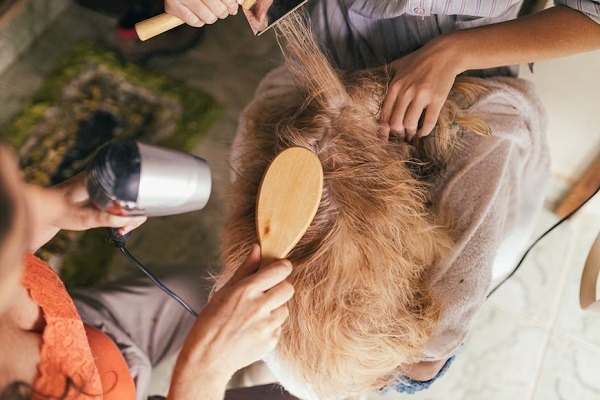Grooming Your Dog at Home

Grooming your dog is an essential part of pet care. Regular grooming not only keeps your dog looking clean and healthy but also allows you to monitor your pet’s health more closely. While professional groomers can certainly help, learning to groom your dog at home can save you money, and more importantly, can become a bonding experience between you and your pet.
Brushing
Brushing is vital, regardless of the length of your dog’s coat. Regular brushing helps to remove dirt, prevent tangles, distribute natural oils throughout the coat, and shed loose hairs.
Choosing the Right Brush: Brushes come in a variety of types. Bristle brushes are good for short-haired, smooth-coated dogs. Wire-pin brushes work well for dogs with long, curly, or woolly hair. Slicker brushes, with their fine, short wires close together, are perfect for removing tangles and mats in medium to long-haired dogs.
Technique: Brush in the direction of hair growth. Start from the head, move towards the tail, and down the legs. Be gentle, especially when dealing with tangles. For severe mats, it might be safer to cut them out or visit a professional groomer.
Bathing
Giving your dog a bath helps to keep their coat and skin clean. However, bathing too often can strip the skin of its natural oils. For most dogs, a monthly bath is sufficient unless they get into something particularly dirty.
Choosing the Right Shampoo: Use a dog-friendly shampoo that suits your dog’s skin type. Do not use human shampoo as the pH level is not appropriate for dogs. Getting the proper shampoo for your dog is readily available in shops that market dogs online.
Technique: Wet your dog thoroughly before applying shampoo. Work the shampoo in with your fingers, from neck to tail, then down the legs. Rinse thoroughly to avoid leaving any residue that can irritate the skin.
Ear Cleaning
Dog’s ears can be a breeding ground for bacteria and yeast if not kept clean. Some dogs might require weekly ear cleanings, while others do fine with cleanings every month.
Materials Needed: Purchase a vet-recommended dog ear cleaner. You’ll also need cotton balls or pads.
Technique: Soak a cotton ball with the cleaner, then wipe the inside of the ear flap gently. Never insert anything into the ear canal itself. If you notice redness, bad odour, or an unusual amount of wax, it’s time to consult your vet.
Teeth Cleaning
Regular dental care is crucial to prevent gum disease and other health issues. Ideally, dogs should have their teeth brushed daily.
Materials Needed: Dog toothpaste (human toothpaste can be toxic to dogs) and a dog toothbrush or finger brush.
Technique: Start by letting your dog taste the toothpaste. Lift the lip to expose the teeth and gums, then brush in a circular motion. Make sure to reach the back upper molars and canines, where tartar tends to accumulate.
Nail Trimming
Long nails can cause discomfort and lead to problems with walking. How often your dog needs a trim depends on their activity level and how quickly their nails grow.
Materials Needed: A pair of dog nail clippers or a grinder.
Technique: Hold your dog’s paw steady and cut off a small piece of the end of each toenail. Be careful not to cut into the quick, the pink part inside the nail that contains blood vessels and nerves. If your dog has dark nails and you can’t see the quick, only trim the very end of the nail.
Grooming Different Coat Types
Different breeds have distinct coat types and each requires specific care:
Short-Haired Breeds: These dogs, like Beagles and Dalmatians, require minimal grooming. Regular brushing to remove loose hair and occasional baths are usually enough.
Long-Haired Breeds: Breeds like Shih Tzus and Yorkshire Terriers need daily brushing to prevent tangles and mats. They also need regular hair trims.
Double-Coated Breeds: Breeds such as Huskies and Golden Retrievers have a dense undercoat that requires frequent brushing, especially during shedding seasons. Bathing should be minimal to prevent drying out the skin.
Curly or Wavy Coated Breeds: Poodles and Bichon Frises need frequent brushing to prevent matting. They also require regular trims.
Dog Skin Care and Issues to Watch Out For
Skin problems in dogs are quite common and can stem from allergies, parasites, or underlying illnesses. Regular grooming can help you identify these issues early:
Dry Skin: Signs include dandruff, scratching, and hair loss. It can be due to environmental factors or an underlying health issue. A diet rich in essential fatty acids can help improve skin health.
Hot Spots: These are areas of skin inflammation and infection that can be very painful for your dog. Consult a vet if you notice them.
Allergies: Dogs can have allergic reactions to food, fleas, pollen, or certain substances in their environment. Symptoms can include itching, redness, and skin infections.
Parasites: Fleas and ticks can cause skin irritation, and are also carriers for dangerous diseases. Regular use of flea and tick preventatives is essential.
Conclusion
Grooming your dog at home can be a rewarding experience for both of you. Regular grooming keeps your pet looking their best, contributes to their physical health, and provides an opportunity to strengthen your bond.
Just remember to be patient, especially when you’re first establishing your grooming routine, and always end grooming sessions on a positive note so that your dog starts to look forward to them.
